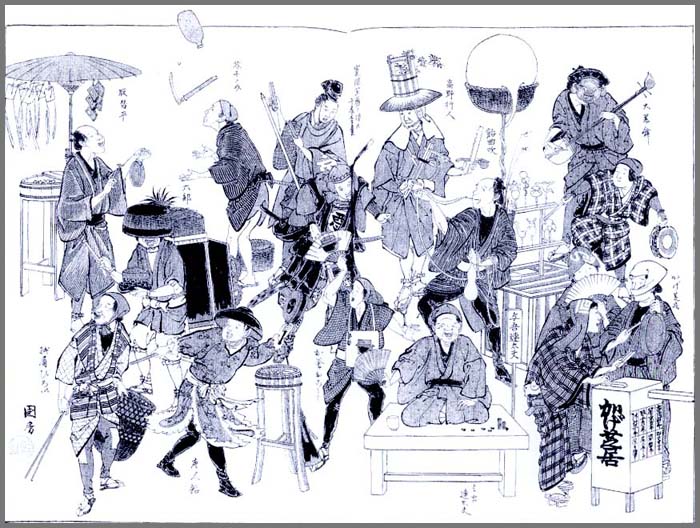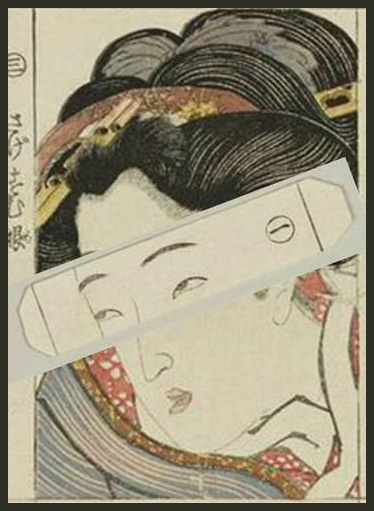[http://edoflourishing.blogspot.jp/2013/11/business-in-edo.html]
[ . BACK to DARUMA MUSEUM TOP . ]
. - Doing Business in Edo - 商売 - Introduction .
:::::::::::::::::::::::::::::::::::::::::::::::::::::::::::::::::::::::::::::::::::::::::::::::::::::::::::::::::::::::::::::::::::::::::::::::::::::::::::::::::::::::::::::::::::::
daidoogei 大道芸 Daidogei street performance
kyokugei 曲芸 stunt artists, acrobatics
yose engei 寄席演芸 vaudeville theater, variety theater
kado geinin 門芸人 performers at the gate (of each estate)
This is part of the main entry about
. Doing Business in Edo - 江戸の商売 .
Street performers were quite popular in an age without television . . .
Especially during the holiday season of the New Year they entertained the townspeople.

CLICK for more illustrations.
:::::::::::::::::::::::::::::::::::::::::::::::::::::::::::::::::::::::::::::::::::::::::::::::::::::::::::::::::::::::::::::::::::::::::::::::::::::::::::::::::::::::::::::::::::::

source : log.goo.ne.jp/htshumei
居合抜きの長井兵助
樽の曲ざし / 青蛙房 / 芝居、新狂言 / 鎌倉節の飴売り / 乞食芝居 / 栗餅の曲つき
:::::::::::::::::::::::::::::::::::::::::::::::::::::::::::::::::::::::::::::::::::::::::::::::::::::::::::::::::::::::::::::::::::::::::::::::::::::::::::::::::::::::::::::::::::::
. dengaku mai 田楽舞 Dengaku dance and performance .
Performers on sticks, with poles and wooden swords
..............................................................................................................................................
hariki 歯力 (はりき)lifting heavy things with the teeth
kuchichikara (kooriki) 口力 "strong mouth"

- source : 江戸は大道芸 -

歯力鬼右衛門の見世物 Oni Uemon with the strong teeth
this photo shows what he could do, in the form of a sugoroku game with 11 fields.
Oni Uemon was born in Kishu Wakayama 紀州和歌山 and soon became a favorite of the street performers in Edo.
He could also break a pottery plate by just biting into it. He could dance while keeping a barrel with two children in his mouth and many other feats to entertain the viewers.
- source : misemono nenpyo -
..............................................................................................................................................
hitorishibai, hitori shibai 一人芝居 one-man theater
often with the left and right side of the body with different make-up and costumes, so one person could play two roles.

Also called
kojiki shibai 乞食芝居 beggar's performance, beggar's play

source : blog.goo.ne.jp/aboo-kai
ひとりふた役乞食芝居や花の下
hitori futayaku kojiki shibai ya hana no shita
one playing two roles
in a poor man's performance -
under the cherry blossoms

. kojiki 乞食 beggar .
- - - - - - and one meaning related to the many fires of Edo
- quote -
Hitsuke tōzoku aratame was a position introduced by the shogunate to target the felonies of arson, theft, and gambling.
... Contrary to the machi-bugyō, who were civil officials, hitsuke tōzoku aratame were military officials. Therefore, their interrogation strategies tended to be violent. While they had the power to arrest suspected arsonists, there was no penalty for mistaken arrests. For this reason, they often tortured the arrested suspects to force confessions, leading to a great number of false charges.
This left a notorious image on the chōnin, who nicknamed them "kojiki shibai" (乞食芝居, lowly theaters) while comparing the machi-bugyō and kanjō-bugyō (勘定奉行, financial commissioner) to "ōshibai" (大芝居, grand theaters).
- source : wikipedia - Fires in Edo -
.......................................................................
. hitorizumoo 一人相撲 / 一人角力 Hitori Sumo - one-man wrestling .
.............................................................................................................................................
hyakumanako, hyaku manako 百眼 "one hundred eyes"
using various simple paper masks (mekazura 目鬘) to represent different emotions in a funny performance.
They were also called shichihenme 七変目 "seven different eyes" (a pun with shichihenge) or nanatsume 七つ目 "seven eyes" and also often performed indoors to entertain visitors.
A favorite was the performance of cleaning teeth, hyakumanako hamigaki 百眼歯磨き.

Playing with mekazura 目鬘 "eye wigs" was also enjoyed by others.

CLICK for more photos !
..............................................................................................................................................
iainuki, iai nuki 居合い抜き sword performance
torite 捕手 / hamahoo 浜法
Exercises with the samurai sword have become showpieces at the roadside.
Some used to sell medicine on the side.

battoojutsu 抜刀術 "the craft of drawing out the sword"
an old term for iaijutsu 居合術.
Iaijutsu (居合術), a combative quick-draw sword technique. This art of drawing the Japanese sword, katana, is one of the Japanese koryū martial art disciplines in the education of the classical warrior (bushi).
- source : wikipedia -

source : htshumei
居合抜きの長井兵助 by 菊池貴一郎著
. selling gamaabura がま油 toad grease .
while performing sword tricks
..............................................................................................................................................
kago nuke, kagonuke 籠抜け / 篭抜け crawling through a narrow bamboo basket
while another sticks a sword into the basket

"Since a horse cannot perform such a nimble trick, "horse's basket trick" uma no kagonuke 馬の籠抜け became a proverb for doing something thought to be impossible. The word kagonuke is also used to describe the act of entering through one door and escaping through another."
quote from google books : Haruo Shirane
Early Modern Japanese Literature: An Anthology, 1600-1900
umanori kozoo no kago nuke 'The horse-riding monk's escape from the basket'
Kagonuke no Yatsushi
Kabuki role in the drama "Tanba Yosaku Tazuma Obi".
..............................................................................................................................................
. kyokugoma 曲独楽 acrobatics with spinning tops (koma) .
. kyokuhe 曲屁 "acrobatic farting" , performance like music .
With all the vegetable food and sweet potatoes, farting was very common in Edo.
..............................................................................................................................................
. makuragaeshi 枕返し juggling with pillows, pillow turner .
..............................................................................................................................................
. Nanjing Tamasudare たますだれ (玉簾/珠簾) .
performance with bamboo sticks
.......................................................................
nazotoki 謎解き/ nazokake なぞかけ making riddles
「○○とかけて××と解く。その心は」
"I call it ooo and explain it as xxx. The reason is this yyy!"
This kind of riddle story is still popular on present-day TV.
nazotoki boozu 謎解き坊主春雪の見世物 was quite popular around 1815.
謎坊主春雪 Nazotoki Bozu Shunsetsu. He worked at a mountain in the back of Asakusa Kannon in Edo.
カケル大食傷トクしろほうきみごぼうき心は立てはき居てはく
カケルはげあたまトクおとし味そ心はすらずとよい

source : misemono/archives
..............................................................................................................................................
o-chiyobune, ochiyobune お千代舟 O-Chio Boat
performed by beggars to get some money.
O-Chio was a general name for the woman who had to work as prostitutes on a boat owned by their husband.
. funamanjuu 船饅頭 "sweet buns on a boat" .
The street performers imitated this business boat and made people laugh by doing some rhythmical swinging.

source : 絵で見る江戸のユーモア
..............................................................................................................................................
. sekizoro 節季候 Year End Singers .
December Singers, Twelfth Month Singers
..... female singers, old ladies, ubara 姥等 うばら
..... hitting the breasts, mune tataki 胸敲 むねたたき
..............................................................................................................................................
taiheiki yomi 太平記読み reading the Taiheiki story
reciting the Taiheiki Saga
The origin of koza story telling.
koodan 講談 kooza 講座 kooshaku 講釈

source : supernil.web.fc2.com/rekisiga
"oral commentary on the Record of Great Peace"
Rethinking East Asian Languages, Vernaculars, and Literacies, 1000–1919
- - - - - Read more
- source : books.google.co.jp -
The Taiheiki (太平記)
is a Japanese historical epic written in the late 14th century.
It deals primarily with the Nanboku-chō, the period of war between the Northern Court of Ashikaga Takauji in Kyoto, and the Southern Court of Emperor Go-Daigo in Yoshino.
- - - More in the WIKIPEDIA !
Kōdan (講談, formerly known as kōshaku (講釈)),
is a style of traditional oral Japanese storytelling. The form evolved out of lectures on historical or literary topics given to high-ranking nobles of the Heian period, changing over the centuries to be adopted by the general samurai class and eventually by commoners, and eventually, by the end of the Edo period, declining in favor of new types of entertainment and storytelling such as naniwa-bushi. It was at this time that the term kōshaku was abandoned and kōdan adopted.
Today, after a failed attempt to revive the art in 1974, there are four schools of kōdan and only a very few performers between them.
- - - More in the WIKIPEDIA !
..............................................................................................................................................
. tori oi 鳥追 chasing away the birds .
A ceremony held on the "Small New Year", now January 14 or 15.
done by kado geinin 門芸人
..............................................................................................................................................
. yaku harai, yakuharai 厄払い / 厄はらい exorcism, driving out bad luck .
- during the Setsubun rituals at the beginning of spring
:::::::::::::::::::::::::::::::::::::::::::::::::::::::::::::::::::::::::::::::::::::::::::::::::::::::::::::::::::::::::::::::::::::::::::::::::::::::::::::::::::::::::::::::::::::
- reference -
江戸浅草奥山 - - source : misemono nenpyo -
畸人(きじん) 不具者を見世物 strange people / 珍畸鳥獣 strange beasts
- source : kappa/watashi -
:::::::::::::::::::::::::::::::::::::::::::::::::::::::::::::::::::::::::::::::::::::::::::::::::::::::::::::::::::::::::::::::::::::::::::::::::::::::::::::::::::::::::::::::::::::
- - - - - H A I K U and S E N R Y U - - - - -
大道芸炎天に置く銭の箱
daidoogei enten ni oku zeni no hako
these street performers -
under the blazing sky
a box for donations
Tr. Gabi Greve
Kashiwara Min-U 柏原眠雨
. WKD : enten 炎天 blazing sky .
..............................................................................................................................................
大道芸なべて陽炎ふ自由席 高澤良一
大道芸にどつと声湧く半夏生 守谷順子
大道芸の鞄開けば小鳥来る 一 民江
に置く銭の箱 柏原眠雨
大道芸祭囃すやオッペケペー 高澤良一 素抱
大道芸蒸す日を火噴き男かな 高澤良一 寒暑
もみづる樹下大道芸の下準備 高澤良一 素抱
冬帽子大道芸の銭集む 山口超心鬼
冬眠す大道芸の帽子中 対馬康子 吾亦紅
小樽初夏大道芸も運河べり 小倉英男
島寺に大道芸やさくら満つ 中戸川朝人 星辰
永日の掏摸も輪中に大道芸 高澤良一 寒暑
沙翁忌の大道芸の紙吹雪 永澤 謙
父の日に大道芸の傘ひらく 角谷憲武
野毛山下春ともなれば大道芸 高澤良一 寒暑
- source : HAIKUreikuDB
:::::::::::::::::::::::::::::::::::::::::::::::::::::::::::::::::::::::::::::::::::::::::::::::::::::::::::::::::::::::::::::::::::::::::::::::::::::::::::::::::::::::::::::::::::::

- - - To join me on facebook, click the image !
:::::::::::::::::::::::::::::::::::::::::::::::::::::::::::::::::::::::::::::::::::::::::::::::::::::::::::::::::::::::::::::::::::::::::::::::::::::::::::::::::::::::::::::::::::::
. Japanese Architecture - cultural keywords used in haiku .
. - Doing Business in Edo - 商売 - Introduction .
[ . BACK to DARUMA MUSEUM TOP . ]
[ . BACK to WORLDKIGO . TOP . ]
:::::::::::::::::::::::::::::::::::::::::::::::::::::::::::::::::::::::::::::::::::::::::::::::::::::::::::::::::::::::::::::::::::::::::::::::::::::::::::::::::::::::::::::::::::::
--
Posted By Gabi Greve to Edo - the EDOPEDIA - on 12/27/2013 01:57:00 p.m.

No comments:
Post a Comment